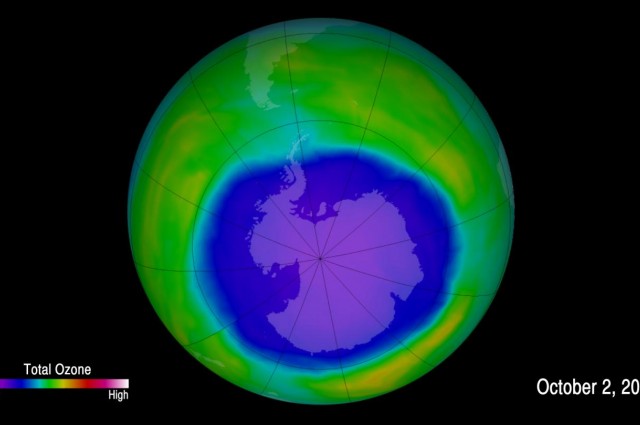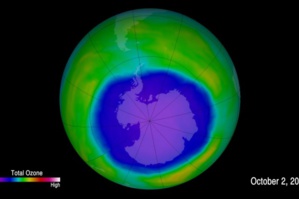A recent report reveals that the hole in the “ozone layer” that protects the earth from the harmful rays of the suns just got bigger this year. The hole is located over Antarctica. The reports inform that it was created very recently. Moreover, the size of the hole is still expanding and at present it equals the size of a hole situated over North America. With this one on the list, 2015 has recorded four largest ozone holes.
In fact, it known that the gap in the ozone layer will contract and expand over a period of time. These holes are the result of “man-made chemicals” that were “pumped into” the atmosphere sometimes in the 1980s. Nevertheless, the N.A.S.A scientists reassure that “there is no need to panic” for from a data collection of “long-term trends” it has been revealed that the damage done to the Ozone layer can still be recovered. In the words of the Earth Sciences’ chief scientist at “NASA's Goddard Space Flight Centre”, Paul Newman:
“While the current ozone hole is larger than in recent years, the area occupied by this year's hole is consistent with our understanding of ozone depletion chemistry and consistent with colder-than-average weather conditions in Earth's stratosphere, which help drive ozone depletion”.
As mentioned earlier the layer of ozone gas that surrounds the planet earth “absorbs most of the ultraviolet radiation from the Sun” whereby protects the world from the “harmful effects” of ultra violet radiations. However, in the years of 1980s scientists found that some “man-made compounds” like chlorofluorocarbon (CFC) was causing massive damage to the layer of ozone gas. Consequently, the layer was thinning down to the extent that humans were at the risk of adverse health effects. This lead to the ban of CFCs. Nevertheless, the hole that has developed over Antarctica “has remained”.
The iflscience.com informs:
“Ozone is made up of three oxygen molecules bonded together and is created naturally in the stratosphere around 32 kilometers (20 miles) up in the atmosphere by sunlight. The total amount of ozone in the atmosphere is thought to be around three billion tons, but even then this only accounts for around 0.00006% of the atmosphere. Chemically active forms of chlorine and bromine that make it up into the stratosphere, much of which comes from human pollution, reacts with the ozone and destroys it”.
While, in a statement received from NOAA, Bryan Johnson remarked:
“This year, our balloon-borne instruments measured nearly 100% ozone depletion in the layer above South Pole Station, Antarctica, that was 14 to 19 kilometers (9 to 12 miles) above Earth's surface. During September we typically see a rapid ozone decline, ending with about 95% depletion in that layer by October 1. This year the depletion held on an extra two weeks resulting in nearly 100% depletion by October 15.”
References:
www.iflscience.com
In fact, it known that the gap in the ozone layer will contract and expand over a period of time. These holes are the result of “man-made chemicals” that were “pumped into” the atmosphere sometimes in the 1980s. Nevertheless, the N.A.S.A scientists reassure that “there is no need to panic” for from a data collection of “long-term trends” it has been revealed that the damage done to the Ozone layer can still be recovered. In the words of the Earth Sciences’ chief scientist at “NASA's Goddard Space Flight Centre”, Paul Newman:
“While the current ozone hole is larger than in recent years, the area occupied by this year's hole is consistent with our understanding of ozone depletion chemistry and consistent with colder-than-average weather conditions in Earth's stratosphere, which help drive ozone depletion”.
As mentioned earlier the layer of ozone gas that surrounds the planet earth “absorbs most of the ultraviolet radiation from the Sun” whereby protects the world from the “harmful effects” of ultra violet radiations. However, in the years of 1980s scientists found that some “man-made compounds” like chlorofluorocarbon (CFC) was causing massive damage to the layer of ozone gas. Consequently, the layer was thinning down to the extent that humans were at the risk of adverse health effects. This lead to the ban of CFCs. Nevertheless, the hole that has developed over Antarctica “has remained”.
The iflscience.com informs:
“Ozone is made up of three oxygen molecules bonded together and is created naturally in the stratosphere around 32 kilometers (20 miles) up in the atmosphere by sunlight. The total amount of ozone in the atmosphere is thought to be around three billion tons, but even then this only accounts for around 0.00006% of the atmosphere. Chemically active forms of chlorine and bromine that make it up into the stratosphere, much of which comes from human pollution, reacts with the ozone and destroys it”.
While, in a statement received from NOAA, Bryan Johnson remarked:
“This year, our balloon-borne instruments measured nearly 100% ozone depletion in the layer above South Pole Station, Antarctica, that was 14 to 19 kilometers (9 to 12 miles) above Earth's surface. During September we typically see a rapid ozone decline, ending with about 95% depletion in that layer by October 1. This year the depletion held on an extra two weeks resulting in nearly 100% depletion by October 15.”
References:
www.iflscience.com






